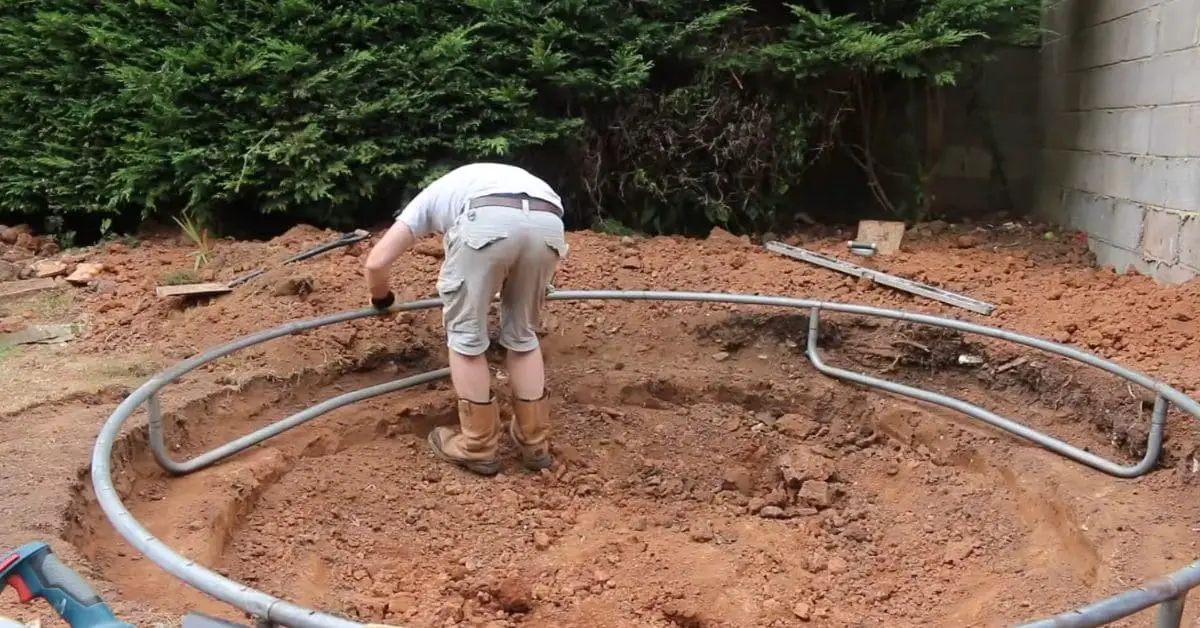Are you worried about how to prepare the ground for a trampoline? When preparing the ground for a trampoline, it’s crucial to prioritize safety and stability. To begin, identify a suitable location free of any overhead obstructions like trees or power lines.
Clear the area of debris, rocks, or sharp objects that could be hazardous. Ensure that the ground is as level as possible to prevent any potential hazards. Use stakes or spray paint to mark the perimeter and dig a hole that is the same size and shape as the trampoline frame, making sure it’s at least as deep as the frame.
Pour a layer of gravel into the hole to prevent the trampoline from sinking into the ground and aid in drainage. Follow the manufacturer’s instructions to install the trampoline and ensure it’s level and secure.
Lastly, surround the trampoline with safety measures such as a safety net or padding and remind everyone to follow safety guidelines while using it, such as only one person at a time, no flips, and proper jumping technique. With these steps, you can guarantee a safe and enjoyable trampoline experience.
How to Prepare the Ground for a Trampoline: Preparing the ground for a trampoline involves identifying a suitable location, clearing the area of debris, leveling the ground, digging a hole, pouring gravel, and installing the trampoline securely.
Getting the Ground Ready
When it comes to setting up a trampoline, safety is key. As a general rule, it’s best to install your trampoline in an open space, free from any obstacles such as shrubs, trees, poles, or garden furniture. This will help ensure the safety of the equipment itself and anyone using it.
To prepare the ground for your trampoline, there are a few important steps you should follow.
How to Prepare the Ground for a Trampoline Prepare :
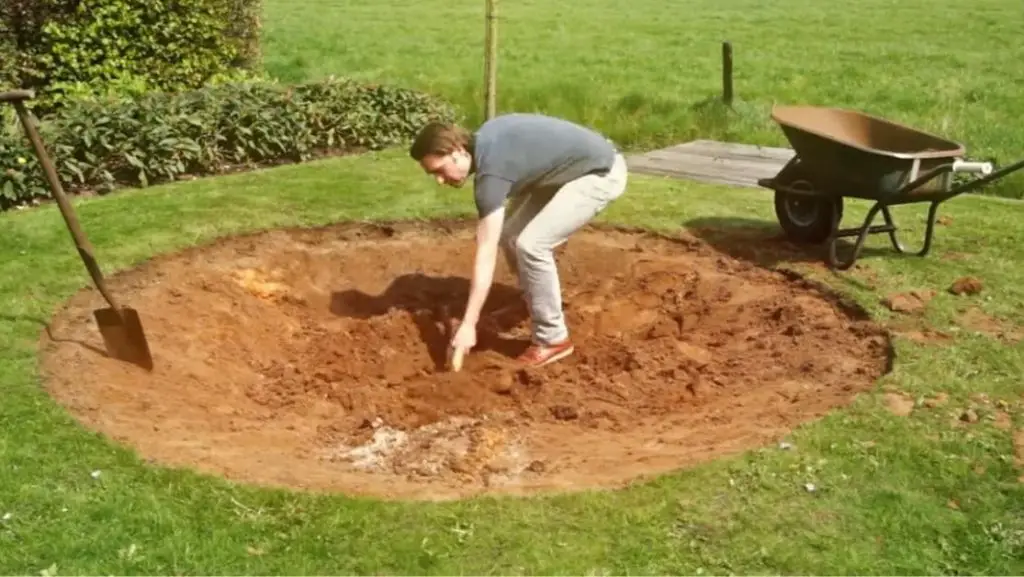
Preparing the ground is a crucial step before setting up a trampoline. Clearing the area is necessary, which includes cutting the grass, and removing trees, bushes, and debris. It’s essential to ensure that there are no obstacles near the trampoline to avoid any accidents.
Install the trampoline in an area that is free from stones, tree stumps, and any other hazards. The ground should be soft and level to ensure the trampoline’s stability and safety during use.
Taking the time to prepare the ground properly will make sure that the trampoline is set up in a safe and enjoyable play area for everyone.
Measure the Trampoline Area:
Before installing a trampoline, it’s important to measure the area to ensure that it fits well. The first step is to determine the appropriate dimensions, which should include about three to four feet of extra space around the trampoline. This extra space is important for safety and easy movement.
Jumpers will find it comfortable to enter, exit, and move around. Additionally, having extra space around the trampoline makes it easier to clean and maintain the unit. You’ll be able to move around it and clean every inch, ensuring that it stays in good condition and is safe for use.
Trim the Grass around the Trampoline Area:
When preparing the ground for your trampoline, it’s important to clear the area of any grass. This will make the installation process smoother and prevent grass from growing and reaching the mat, which could be dangerous.
Additionally, removing the grass can help prevent predators like snakes from nesting under the trampoline. It’s a good idea to keep the area beneath the trampoline as clear and free from debris as possible to maintain a safe environment for jumpers.
Level the Ground Surface for Trampoline:
For safety reasons, it’s important to install the trampoline on a level surface. Sloping or uneven ground increases the risk of accidents and injuries. Before installing the trampoline, inspect the yard to ensure it’s flat and level. If it’s not, you’ll need to do some extra work to level it.
Be cautious, though. Depending on the surface condition, you may need to add or remove materials while leveling. It’s important not to raise the surface so high that it touches the trampoline surface.
To provide a sturdy base for the trampoline, it’s important to place a hard material under the feet. This will prevent the feet from sinking into the soft ground and ensure the trampoline’s stability.
Leveling the ground also helps to balance the trampoline and prevent any damage to its parts, which can extend its lifespan.
Checking the Ground for Stability:
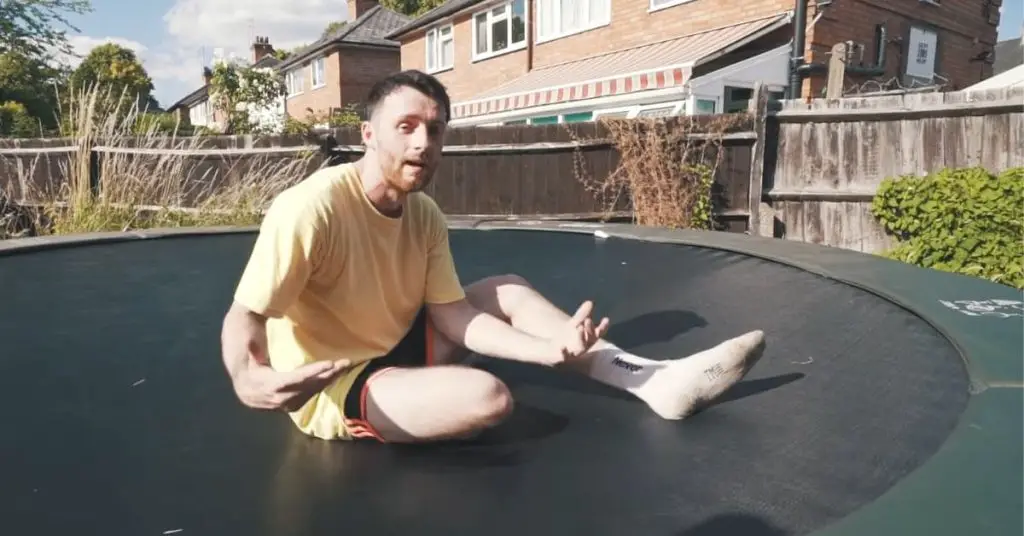
It’s essential to have sturdy ground to hold the weight of a trampoline and jumpers. The weight of the unit and the kids requires a solid foundation to hold the legs in place and prevent wobbling or tipping.
When people jump on a trampoline, it creates a rhythmic thudding force that puts pressure on the legs/posts. Therefore, you need consistent solidness across all the supporting legs/posts to keep the unit stable and prevent accidents.
Swampy or unstable grounds are not recommended, and it’s necessary to reinforce them correctly. Otherwise, the legs may sink into the ground after a few jumps, leading to an unstable trampoline.
It’s not advisable to place a trampoline on concrete because it relies on the shock absorption capacity of the ground to absorb bounces that aren’t absorbed by its springs.
So make sure to inspect the ground thoroughly before installing the trampoline to ensure it can support the weight of the unit and jumpers safely.
Install a Drainage System:
To avoid water damage and potential health hazards, it’s important to have a proper drainage system in place around your trampoline. Without it, rainwater can accumulate and cause instability and damage to the unit.
In addition, stagnant water can attract pests and spread diseases. To ensure safety, construct a drain that redirects rainwater away from the trampoline area. Adding a drain rock can also make maintenance easier.
What should be done if the ground is sloping?
If you live in an area with a sloped yard, it can be challenging to level the surface for a trampoline. It’s not safe to install a trampoline on an uneven surface because it poses various risks.
The imbalance of the trampoline on a slope can cause injuries to jumpers upon landing. Moreover, the trampoline mat and springs will wear and tear more quickly due to the uneven pressure.
Besides, the trampoline can tip over and cause harm to users when it leans on one side of a slope. Therefore, it’s necessary to level the surface of your backyard, which may require light excavation.
Preparing the Surface for an In-Ground Trampoline
Getting ready to install an in-ground trampoline involves a different approach than an above-ground one.
Before starting, it’s important to check if the site is located in a high water table area by digging a trial hole of about 3 feet deep and letting it sit for 24 hours to see if it fills up.
Once you confirm that it’s not in a high water table area, you can start digging the hole. It should be 1 foot larger than the circumference of the trampoline and dug during a dry period. Don’t dispose of the soil, as you may need it to refill the hole or create a donut.
It’s also essential to dig the hole to the same height or slightly higher than the trampoline. This allows air to escape during jumping, but you can also use air vents instead of raising the mat.
Preparing the Drainage System for a Sunken Trampoline
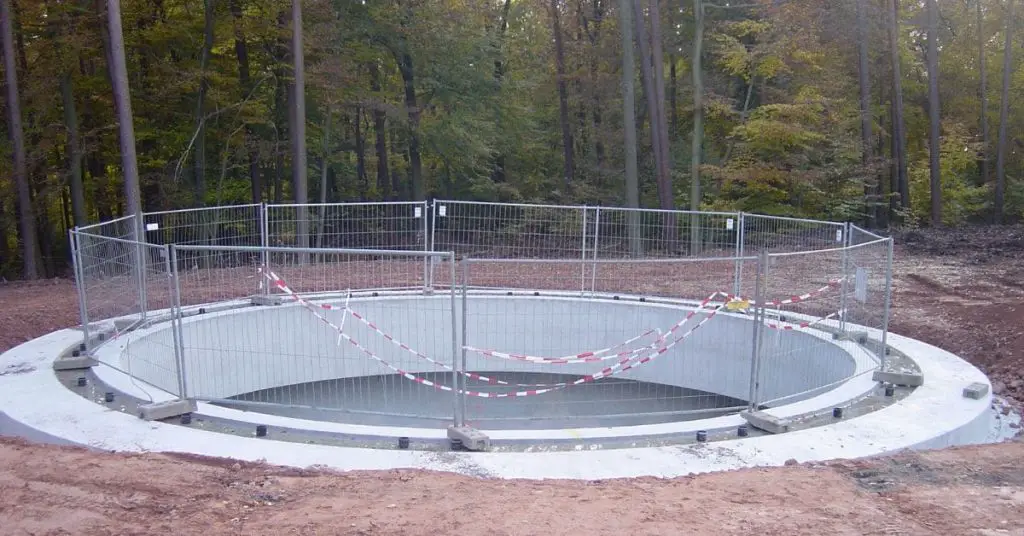
If you live in an area with sandy, porous soil, you won’t have to worry about drainage issues when installing an in-ground trampoline. However, if your soil is not porous, you may encounter a problem where water collects in the hole and creates a pond.
To avoid this, you can create a soak-away at the bottom of the trampoline hole. This involves digging an extra trench and filling it with hardcore or gravel. However, sometimes this may not be enough and additional drainage measures may be necessary.
It’s possible to install the drainage system either before or after installing the trampoline.
What are some ways to make the ground comfortable for a trampoline?
While we do our best to ensure safety when using trampolines, accidents such as falling off can still occur. However, we can reduce the risk of injury from falls by making sure the ground beneath the trampoline is not hard or rough.
To achieve this, we can add something soft on the ground to cushion the impact of a fall.
Here are some suggestions on what can be used as a cushion under the trampoline.
Using Rubber Mulch as a Ground Cover for Trampolines:
Rubber mulch is a great choice for providing a soft landing surface when someone falls off a trampoline. You may have noticed that many playgrounds and football fields use rubber mulch because it is durable and bouncy.
Using rubber mulch under your trampoline can greatly improve safety and you won’t need a thick layer of it. It also helps prevent any grass, weeds, or plants from growing underneath.
To apply rubber mulch, dig a circle or shape that matches the trampoline size, then extend the mulch beyond the trampoline’s dimensions. Spread the mulch over the designated area.
The only downside to using rubber mulch is the cost, which may not be ideal if you’re on a tight budget.
Grass Mats or Artificial Grass as Ground Cover for a Trampoline:
Using artificial grass or a grass mat under your trampoline can be a good alternative if you want the look of real grass without the hassle of maintenance. Artificial grass is low maintenance and won’t require you to move your trampoline for grass to grow. Plus, it looks great!
The grass mat can also provide some cushioning to reduce the risk of injury if someone falls. However, this option can be expensive, so it may not be the best choice if you are on a tight budget.
Ultimately, choosing a soft surface under your trampoline will help make jumping safer and reduce the risk of injury from falls.
Using Wood Chips or Sawdust for a Safe Trampoline Ground:
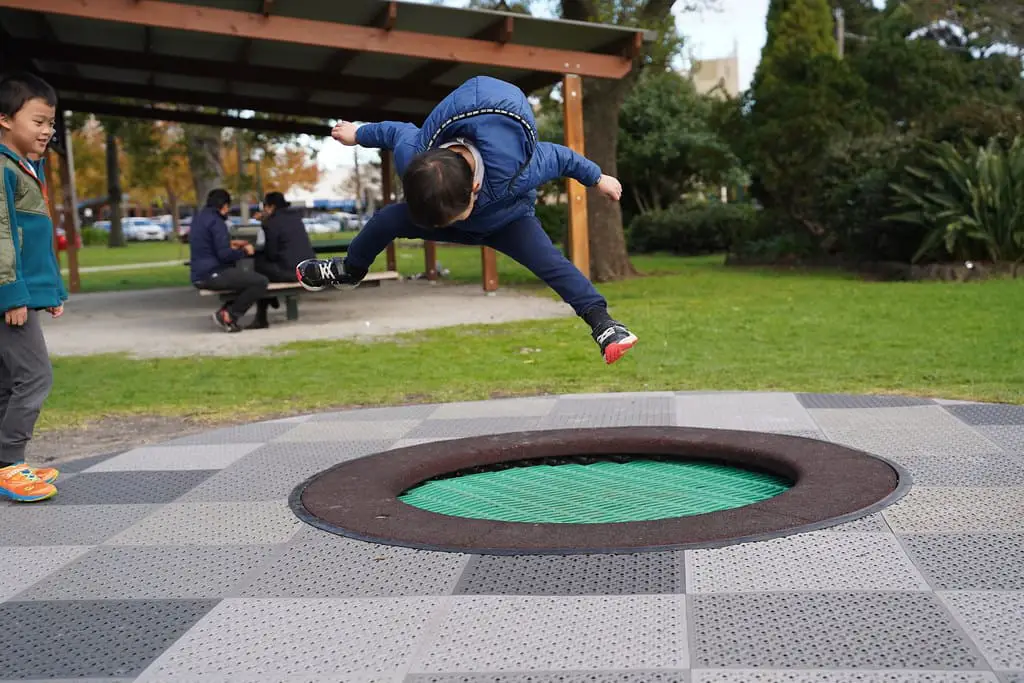
Wood chips have long been used as a cushioning material for play areas. They are a cost-effective option that is readily available, making them a great choice for under your trampoline.
You can easily find bags of wood chips to spread around the entire area where you’ll be installing your trampoline. They will cover the ground and prevent any growth underneath, providing a soft and comfortable landing surface.
In the end, using wood chips saves you the hassle of cutting grass and ensures comfort while using the trampoline.
Using Play Sand as Padding for Your Trampoline:
Play sand is a soft material that provides good impact absorption, similar to rubber mulch. Falling on play sand will not result in a hard impact. However, the main issue with using play sand is its cost, which is also expensive like rubber mulch.
Using Rubberized Mats for Trampoline Flooring:
Rubber mats have come a long way as a trampoline padding option and now come in various colors and densities. You can order it in sheet form or as little bonded pieces to fit your preferred shape.
If you’re worried about your children falling from the ladder or if you decide not to install a safety net, using rubber matting can provide extra protection to prevent falls.
Using Concrete as a Surface for Your Trampoline:
Trampoline experts generally advise against using a concrete surface as a foundation for your trampoline. However, if the concrete pad is treated to make it suitable for a trampoline, it can be used.
Concrete is not able to absorb the shock of jumping on a trampoline, which can make it difficult to secure the base even with anchoring kits. The hard surface can also cause damage to the frame and legs due to repeated friction. Therefore, it is not recommended to place the trampoline directly on a concrete surface.
Design and Aesthetics for Trampolines
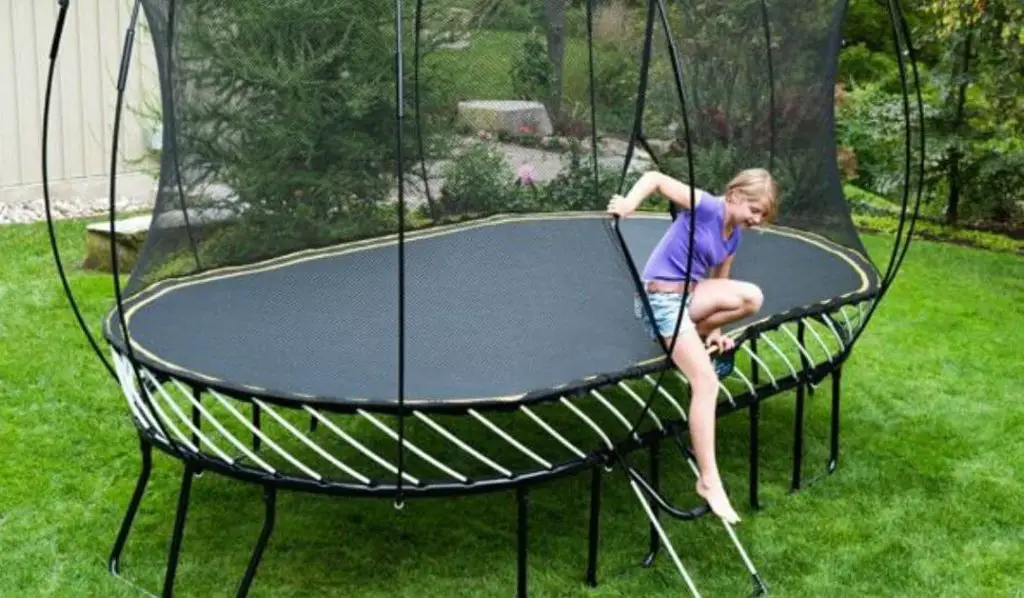
Trampolines aren’t just for bouncing anymore; they’ve become a stylish addition to your backyard too! With a wide range of colors, patterns, and designs to choose from, trampolines can add a unique touch to your outdoor space.
The Alleyway:
Creating an alleyway in your yard is a great way to enhance the overall look of your outdoor space. You can use cobblestone, stepping stones, or pavement as the base material.
To make the path even more appealing, you can add other features along the way, such as a swing set, a pool, or benches, to create a cohesive connection between all elements in your yard.
Designing with Flower Beds and Other Plants:
Creating a safe and separate play area can be achieved by planting hedges around the perimeter of your yard. The hedges provide privacy and reduce noise levels while also acting as a barrier against the wind.
To enhance the aesthetics of your trampoline, you can create a beautiful flower bed around it. Some plants can even be planted underneath the trampoline as long as they don’t grow more than three feet in height.
Install the trampoline
When installing a trampoline, it is crucial to carefully follow the manufacturer’s instructions. These instructions typically include specific guidelines for assembling the frame, attaching the springs and mat, and securing the safety net (if included).
It is essential to ensure that all components are properly installed and tightened to prevent any accidents.
It is also important to make sure that the trampoline is level and secure. To do this, use a level to check that the ground where the trampoline will be placed is even. If the ground is not level, use shims to level it out before placing the trampoline on top.
Once the trampoline is in place, secure it to the ground with appropriate anchors. This will prevent it from tipping or shifting during use. It is recommended to use anchors that are specifically designed for trampolines and to follow the manufacturer’s instructions for installation.
Before allowing anyone to use the trampoline, double-check that it is securely anchored and all components are properly installed and tightened. Safety should always be a top priority when using a trampoline.
Surround the trampoline with safety measures
Trampoline safety is paramount, and there are various safety measures that can be implemented to ensure the well-being of users. One of the most important safety features is a safety net.
A safety net provides a physical barrier around the trampoline, preventing users from falling off and potentially getting injured. It’s important to follow the manufacturer’s instructions when installing the safety net to ensure that it’s properly secured.
In addition to a safety net, it’s also recommended to use padding around the edges of the trampoline. This can help prevent injuries if someone accidentally lands on the edge of the trampoline.
The padding should be made of high-quality materials and be thick enough to provide adequate protection.
It’s also important to remind users of the safety guidelines when using the trampoline. For example, only one person should be on the trampoline at a time to prevent collisions and injuries. Users should also avoid performing dangerous tricks or flips that could result in injury.
Overall, taking the necessary safety precautions when using a trampoline can help prevent injuries and ensure that everyone has a fun and safe experience.
FAQs:
Q:1 Why is it important to prepare the ground before installing a trampoline?
Preparing the ground for a trampoline is crucial for ensuring a safe and stable base for the equipment. A properly installed trampoline can prevent accidents and injuries, as well as extend the lifespan of the trampoline.
Q:2 What’s the best location for installing a trampoline?
The best location for a trampoline is a flat and level area that’s clear of obstacles, such as trees or overhead wires. Avoid placing the trampoline on concrete, asphalt, or other hard surfaces, as they don’t absorb shock well and can cause damage to the trampoline.
Q:3 How do I level the ground for a trampoline?
To level the ground for a trampoline, you can use a shovel, rake, and a level. Start by removing any grass, rocks, or debris from the area. Then, use the shovel to dig out high spots and fill in low spots with soil. Finally, use the level to ensure the ground is even and flat.
Q:4 What materials can I use to prepare the ground for a trampoline?
There are several materials you can use to prepare the ground for a trampoline, such as grass, gravel, sand, rubber mulch, or wood chips. The material you choose will depend on your personal preference, budget, and the type of trampoline you have.
Q:5 How much space should I leave around the trampoline?
It’s important to leave enough space around the trampoline for safety reasons. Experts recommend leaving at least 6 feet of clear space on all sides of the trampoline, including overhead clearance.
Q:6 Do I need to use an anchor kit for my trampoline?
Yes, it’s highly recommended to use an anchor kit for your trampoline to secure it in place and prevent it from tipping over or moving during use. Anchor kits are available from most trampoline manufacturers and can be easily installed.
Q:7 Can I put a trampoline on a hill or slope?
No, it’s not safe to put a trampoline on a hill or slope. The trampoline needs to be on a flat and level surface to ensure stability and prevent accidents. If you don’t have a flat area, you may need to consider leveling the ground or finding a different location for your trampoline.
Conclusion:
In conclusion, properly preparing the ground for a trampoline is a crucial step in ensuring the safety and longevity of the equipment. Before installing a trampoline, it is important to select a suitable location, clear the area of any potential hazards, and level the ground.
Using a ground cover, such as rubber mulch or sand, can also provide added safety benefits. Properly anchoring the trampoline and installing safety measures, such as a safety net and padding, are essential steps in preventing injuries.
It is important to follow the manufacturer’s instructions for installation and to regularly inspect the trampoline for any signs of wear or damage. By taking these precautions and regularly maintaining the trampoline and its surrounding area, users can safely enjoy this fun and exciting equipment for years to come.
With a little bit of effort and attention to detail during the preparation process, families can create a safe and enjoyable environment for their children to jump and play.
We hope you will be well aware of how to prepare the ground for a trampoline, after reading this comprehensive article. If you have any questions, feel free to comment below!

